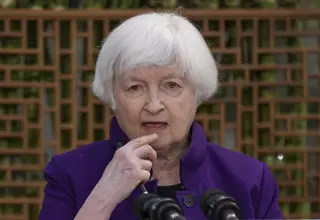Small Danish Town Sees the Big Picture with Profitable Emissions Cuts

Kalundborg. What do the world's largest manufacturer of diabetes drugs, the biggest industrial enzymes producer and a leading offshore power company have in common? In the Danish seaside town of Kalundborg they have plenty.
As pioneers of so-called industrial symbiosis, these companies swap waste and byproducts to cut costs and carbon dioxide (CO2) emissions profitably -- an approach that offers big business a financial incentive that could be crucial to nations striving to meet targets agreed at this month's global climate summit.
Their success has attracted attention globally, with more than 30 corporate and municipal delegations from 20 countries visiting the town this year, including mayors from China's fast-growing Guandong province.
Drugmaker Novo Nordisk, enzyme producer Novozymes and DONG Energy
The continually evolving model first attracted academia in the 1990s and prompted the creation of the Symbiosis Centre in the town. Its head, Mette Skovbjerg, says businesses digesting the historic emissions deal could learn from Kalundborg.
"What's attractive is that it's fairly easy for companies to see themselves in this model. They're not just going green but going on a path that is very similar to how they do business normally," she said.
"The driver for this type of collaboration is actually to reduce production costs, not CO2 emissions. The real issue is to achieve primary goals companies have; to secure supplies and access to resources. That's a logic they understand."
There are 30 types of materials -- ranging from steam, water and condensate to ash, sand, ethanol and biomass -- exchanged between companies and utilities in 50 processes at Kalundborg. What's useless for one, is useful for another.
Steam from DONG's power station is pumped along pipelines around town to the Novo Nordisk and Novozymes plants, where it is used as a cleaning agent, and to the refinery, where it is used in several processes.
The power station's ash and gypsum waste are moved to a cement company and a plasterboard maker respectively.
Novo Nordisk and Novozymes' waste water is purified for municipal use, while their leftover biomass is converted to fertilizer. Statoil, too, has reduced emissions by turning waste sulphur and nitrogen into fertilizer and also feeds back used water to the power station and a water reservoir.
EMISSIONS CUT, MILLIONS SAVED
Managers at all manner of businesses are attracted by such efficiency improvements, costs savings and value-added products.
European Union institutions are embedding the idea of a so-called circular economy in a number of action plans and papers, and the European Commission says it promotes replication of Kalundborg in its 80 billion euro ($87 billion) Horizon 2020 innovation and growth project.
"The town of Kalundborg has been one of the pioneers ... The Commission recognized it as a best-practice example of effective resource saving and recycling of materials in industrial production," Commission spokesman Enrico Brivio said.
The nature of the project means benefits are difficult to quantify precisely. The Symbiosis Center calculated emission cuts as a result of the product exchanges at 270,000 tonnes of CO2 a year in 2008.
It is in the process of updating that calculation and expects a significant increase thanks to new projects.
Total greenhouse emissions in Denmark in 2008 amounted to 63.8 million tonnes, down 3 million tonnes from the previous year, though emissions have since varied from rising to falling by as much as 6 million tonnes, Danish Energy Agency data shows.
Savings are also hard to calculate partly because of the variety of exchanges but mostly because each process is part of a commercial deal between companies, with financial details undisclosed.
Business consultancy Copenhagen Economics estimated cost savings at Kalundborg to be between 500 million and 600 million Danish crowns ($72 million to $87 million) a year, based on interviews with executives, in a 2013 report looking at whether the wider Copenhagen region should adopt the model.
That may not be a significant amount for the likes of Novo Nordisk, which produces half of the world's insulin in Kalundborg and reaps annual revenue of $10 billion, but it does show emissions cuts do not have to cost.
And that seems to be enough for the streams of visitors to Kalundborg.
The Symbiosis Centre has presented the model to top Chinese Communist Party official Yu Zhengsheng and has partnered with the Tianjin Economic Technological Development Area, an ecological industrial park close to the Chinese port city.
Delegations from Singapore, Malaysia, Egypt and Kenya all visited in the past year, as well as plenty of European groups.
MODEL MOVES ON
A few minutes drive from the industrial hub of Kalundborg lies a greenhouse containing huge tanks in which algae is being grown for a new project cultivating living cells that can clean waste water by consuming pollutants.
The EU-funded project, which takes waste water from Novo Nordisk and Novozymes, is now looking to upgrade the harvesting of algae to a degree that makes production commercially viable. The algae could also be used as feed for fish or have pigments extracted for the medical industry.
The Symbiosis Centre's Skovbjerg says this is a new step for the model.
"Its core was only to take what was a leftover residual from one industry and use it in a different production process. Here, we're using waste water as a growth medium to produce a value-added product," she said as a project leader in the greenhouse showed a dark green paste in a bucket, its use as yet undecided.
Despite such progress, EU funding, widespread praise and a multitude of visitors and academic papers, it must be noted that part of Kalundborg's success is down to four decades of organic growth and, crucially, the fortuitous proximity of key companies around the town.
Peter Laybourn, chief executive of International Synergies, which facilitates similar collaboration between companies in various countries, acknowledges that the proximity factor means the Kalundborg model is limited but the underlying principles remain sound.
The prospect of commercially viable agreements that also cut CO2 emissions is mentioned by all who are looking to emulate Kalundborg regardless of how they label the model, be it industrial symbiosis, a circular economy or eco-industrial park.
"We use the language of business. We don't talk about emissions, we talk about risks and profit. But it just so happens, because we're dealing with materials or energy, we end up getting the environmental benefits as well," Laybourn said.
Reuters
Tags: Keywords:POPULAR READS
Yellen Says Iran's Actions Could Cause Global 'Economic Spillovers'
Iran's missile attack on Israel early Sunday came in response to what it says was an Israeli strike on Iran's consulate in Syria.Takeaways from Prabowo's Responses to Legal Motion Contesting His Election Win
Part of the argument addresses the claim that the candidacy of Gibran Rakabuming Raka, Prabowo’s running mate, is unlawful.Prabowo Camp Cites ‘Procedural Error’ in Legal Challenge by Rival Candidates
The Constitutional Court's main task is to address alleged discrepancies in vote tallies, which neither of the plaintiffs challenged.Apple Wants to Increase Investments in Vietnam
Vietnam has become more important to Apple as the company seeks to diversify its supply chains away from China.China’s Top Diplomat Wang Yi to Visit Indonesia for Cooperation Talks
Chinese top diplomat Wang Yi will chair a policy coordination meeting aimed at strengthening Indonesia-China cooperation.Popular Tag
Most Popular






















